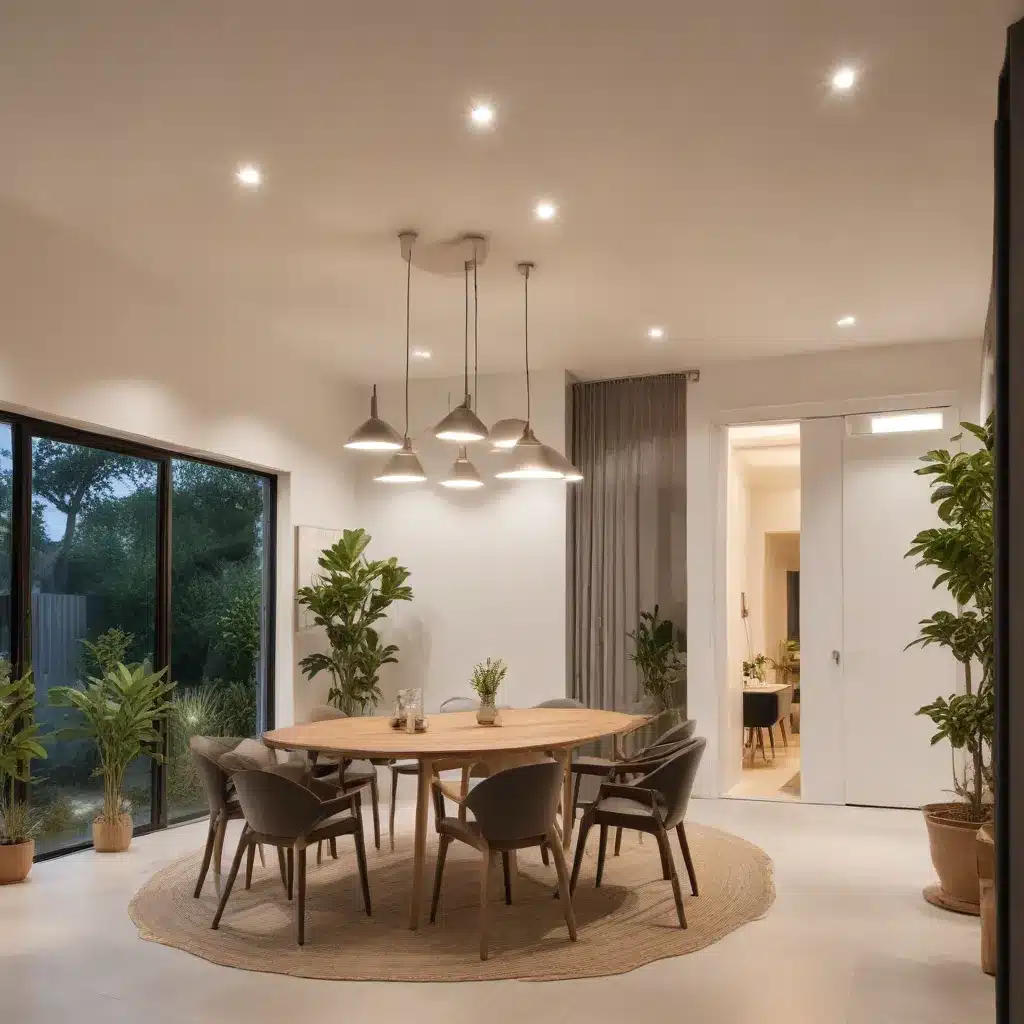
The Benefits of LED Lighting
As a seasoned construction professional and interior designer, I’m excited to share my expertise on upgrading to energy-efficient LED lighting for an eco-friendly home. LED (light-emitting diode) technology has revolutionized the lighting industry, offering a sustainable solution that far outperforms traditional incandescent and fluorescent bulbs.
LEDs consume at least 75% less energy than incandescent bulbs and can last up to 25 times longer, making them a highly cost-effective and environmentally friendly choice for residential and commercial spaces. By transitioning to LED lighting, homeowners can enjoy significant long-term savings on their energy bills while reducing their carbon footprint.
Beyond the tangible energy and cost savings, LED lighting also provides superior light quality that can enhance the aesthetics and ambiance of any room. With a wide range of color temperatures and brightness levels available, LED bulbs can be tailored to complement a home’s interior design and lighting needs.
Upgrading to Sustainable Lighting
When it comes to eco-friendly home upgrades, swapping out old light fixtures and bulbs for energy-efficient LED alternatives is one of the easiest and most impactful changes you can make. Here are some practical tips to guide you through the LED lighting upgrade process:
Assess Your Lighting Needs
Before diving into LED replacements, take the time to evaluate your current lighting situation. Consider the function, brightness, and color temperature requirements for each room or area of your home. This will help you select the right LED bulbs and fixtures that meet your specific needs while maximizing energy savings.
Choose High-Quality LED Bulbs
Not all LED bulbs are created equal. When shopping for LED replacements, look for ENERGY STAR-certified products that offer a high color rendering index (CRI) to ensure accurate color representation. Avoid LED bulbs with a cool, bluish tone, as they can create an unnatural ambiance. Opt for warm or neutral white tones that mimic the comforting glow of traditional incandescent bulbs.
Incorporate Smart Lighting Controls
To further enhance the sustainability and efficiency of your LED lighting setup, consider integrating smart lighting controls. Solutions like occupancy sensors, daylight harvesting systems, and programmable lighting schedules can automatically adjust illumination levels based on room usage and available natural light. These smart technologies can provide impressive energy savings while still maintaining the desired lighting levels throughout your home.
Prioritize LED Fixtures
In addition to swapping out traditional bulbs for LEDs, you can also upgrade your light fixtures to dedicated LED models. LED-integrated fixtures often offer superior efficiency, lifespan, and design flexibility compared to standard fixtures paired with LED lamps. These all-in-one LED solutions can streamline your lighting system and provide a more cohesive, high-performance illumination experience.
Ensure Proper Lighting Placement
The strategic placement of LED lighting is crucial for achieving optimal energy efficiency and lighting quality. Position fixtures near windows to maximize the use of natural daylight, and use task lighting to supplement overhead illumination only where needed. This zoned approach ensures you’re not wasting energy on unnecessary lighting in unoccupied areas.
Leverage Daylight Harvesting
One of the most effective sustainable lighting strategies is to harness the power of natural daylight. Incorporate design elements like skylights, light tubes, and strategically placed windows to bring sunlight deeper into your home’s interior. Pair this with dimmable LED fixtures that can automatically adjust their output based on available daylight, minimizing the need for artificial lighting during the day.
Recycle Old Lighting Responsibly
As you replace your old lighting, be sure to dispose of the fluorescent tubes, compact fluorescent lamps (CFLs), and LED bulbs properly. Many municipalities, utilities, and lighting manufacturers offer recycling programs to safely handle these items and recover the materials for reuse. This helps prevent the release of harmful substances like mercury into the environment.
The Future of Sustainable Lighting
The lighting industry is rapidly evolving, with exciting new technologies on the horizon that promise even greater energy efficiency and sustainability. Organic light-emitting diodes (OLEDs) and quantum dot lighting are two emerging innovations that could soon transform the way we illuminate our homes and businesses.
OLEDs offer a unique, diffused lighting quality through thin, flexible panels that consume less energy than traditional LEDs. Quantum dot technology, on the other hand, allows for highly efficient, tunable LED bulbs that can precisely control the color temperature and hue of the light. As these cutting-edge solutions become more widely available and affordable, the future of sustainable illumination looks increasingly bright.
In the meantime, upgrading to energy-efficient LED lighting remains one of the most impactful and accessible eco-friendly home improvements you can make. By taking advantage of the latest advancements in lighting technology, smart controls, and daylight harvesting strategies, homeowners can significantly reduce their energy usage, save money, and contribute to a more sustainable future.
For more information on sustainable home upgrades and professional construction services, visit https://localbuilderlondon.co.uk/. Our team of experienced builders and designers are dedicated to helping homeowners create energy-efficient, environmentally friendly living spaces.
Key Takeaways
- LED lighting is an extremely energy-efficient and long-lasting technology that can reduce energy consumption by at least 75% compared to incandescent bulbs.
- Upgrading to LED lighting is one of the most impactful eco-friendly home improvements you can make, offering significant long-term cost savings and environmental benefits.
- When selecting LED bulbs, look for ENERGY STAR-certified products with a high color rendering index (CRI) for optimal light quality.
- Integrate smart lighting controls like occupancy sensors and daylight harvesting systems to further enhance the efficiency of your LED lighting setup.
- Leverage natural daylight through strategic window placement, skylights, and light tubes to minimize the need for artificial lighting during the day.
- Properly recycle old lighting fixtures and bulbs to prevent the release of harmful materials into the environment.
- Emerging technologies like OLEDs and quantum dot lighting promise even greater advancements in sustainable illumination in the years to come.
By embracing LED lighting upgrades and other sustainable lighting strategies, homeowners can create a more energy-efficient, eco-friendly living space while enjoying the benefits of enhanced lighting quality and cost savings.


